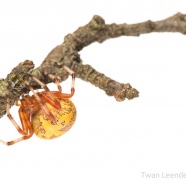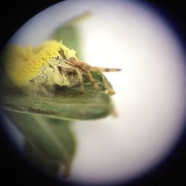The Nature of Halloween
This article by Dr. Scott Shalaway originally appeared in the Post-Journal on October 29th,2016. I thought it was a perfect piece to share given we are hosting a program on snakes, spiders and bats this week! Learn more about “Snakes, Spiders and Bats! Oh, My!” this Friday, October 26th. THE NATURE OF HALLOWEEN Halloween, as I recall, was a day for friends to scare each other with nature’s creepy crawlies – spiders, snakes and bats. And often those fears lasted a lifetime. We all know people who recoil at the sight of these critters. Spiders are probably the most notorious of the...
Read MoreSpider in an Ant Costume
Here’s a nifty, local natural history discovery by RTPI President, Twan Leenders: “I’m used to seeing this kind of trickery in the tropics, but not inside my house. Coolest find of the day: Ant-Mimic Jumping Spider (Myrmarachne formicaria)!”
Read MoreOctober Orbweavers
It’s ‘Meet Your Neighbours Monday’! With the arrival of autumn, you are likely to notice a distinctive suite of spiders around your home. The species shown here is the Marbled Orb Weaver (Araneus marmoreus). The appearance of spiders like this one during the month of October has earned their group the nickname “Halloween spider”. Orb Weavers come in several different colors and patterns, so you might say that they wear a variety of costumes! Marbled orbweaver (Araneus marmoreus) photographed by Twan Leenders.
Read MoreSpider Silk – the Next Sustainable Resource?
Spider silk is the world’s strongest natural fiber known – it is incredibly durable but also extremely lightweight and flexible. One strand of spider silk is one-tenth the thickness of a human hair, and its flexibility resembles that of thread. These qualities are unmatched by other fibers, such as cotton or nylon, giving it a wide variety of industrial applications. The value of spider silk is increased by the fact that it can be a renewable resource. RTPI conservation staff works with the Forman School during research expeditions in Costa Rica to explore the potential to “farm”...
Read MoreZombie Fungus?
During a recent Hemlock Woolly Adelgid survey, one of our volunteers found a little yellow blob attached to a hemlock twig. The mass was clearly not HWA, but curiosity prompted me to bring it back to the office for examination. A closer look under the microscope revealed that the blob actually consisted of a powdery fungus encapsulating a dead spider! After a bit of research, I came to suspect that it might be some sort of Cordyceps; a genus of parasitic fungi capable of taking control of an arthropod, thus directing it to navigate to a favorable position for the fungi’s spores to...
Read More








